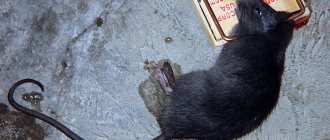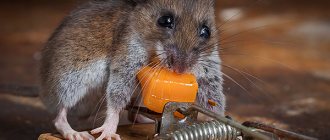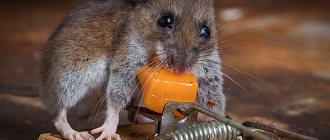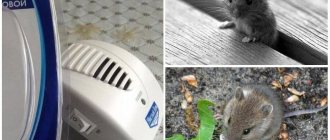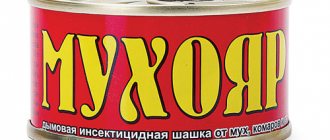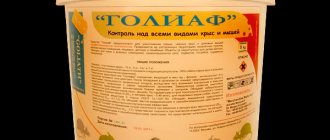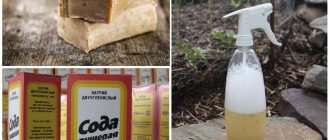In our rat treatments, we use 34 different products, and at most facilities we use a complex of 3-4 drugs and devices. Moreover, what works well in one room or area may turn out to be completely ineffective in another. Therefore, at each specific facility, we select one main anti-rat remedy, and two or three auxiliary ones, and sometimes we find that those same auxiliary ones actually work better and kill more rodents.
Rat in the simplest rat trap
Consequently, there is no universal remedy that is effective and safe always and everywhere. Especially if you need to destroy both rats and mice at the same time. You should always choose either a product or a device based on the conditions in a particular room.
However, it is precisely this arsenal that we have collected that allows us to choose the best rat repellent for a particular object and remove these pests in almost all situations.
Therefore, we will now describe our entire arsenal, dividing the funds from it into groups according to their types and principle of action. For each group, we will indicate the properties, advantages, disadvantages (including implicit ones discovered during application), and say in what cases we use these means. Let's go in order.
Service cost
| Room | Traps | Hot fog |
| 1 room | 3,000 rub. | 5,000 rub. |
| 2 rooms | RUB 3,300 | RUB 5,200 |
| 3 rooms | RUB 3,600 | RUB 5,400 |
| 4 rooms | RUB 3,900 | RUB 5,600 |
| 5 rooms | 4,200 rub. | RUB 5,800 |
Promotions and discounts
#tab_container_2861 { overflow:hidden; display:block; width:100%; border:0px solid #ddd; margin-bottom:30px; } #tab_container_2861 .tab-content{ padding:20px; border: 1px solid #e6e6e6 !important; margin-top: 0px; background-color:#ffffff !important; color: #000000 !important; font-size:15px !important; font-family: Helvetica !important; border: 1px solid #e6e6e6 !important; } #tab_container_2861 .wpsm_nav-tabs { border-bottom: 0px solid #ddd; } #tab_container_2861 .wpsm_nav-tabs > li.active > a, #tab_container_2861 .wpsm_nav-tabs > li.active > a:hover, #tab_container_2861 .wpsm_nav-tabs > li.active > a:focus { color: #000000 !important ; cursor: default; background-color: #ffffff !important; border: 1px solid #e6e6e6 !important; } #tab_container_2861 .wpsm_nav-tabs > li > a { margin-right: 0px !important; line-height: 1.42857143 !important; border: 1px solid #e8e8e8 !important; border-radius: 0px 0px 0 0 !important; background-color: #fbfbfb !important; color: #000000 !important; padding: 15px 18px 15px 18px !important; text-decoration: none !important; font-size: 15px !important; text-align:center !important; font-family: Helvetica !important; } #tab_container_2861 .wpsm_nav-tabs > li > a:focus { outline: 0px !important; } #tab_container_2861 .wpsm_nav-tabs > li > a:before { display:none !important; } #tab_container_2861 .wpsm_nav-tabs > li > a:after { display:none !important ; } #tab_container_2861 .wpsm_nav-tabs > li{ padding:0px !important ; margin:0px; } #tab_container_2861 .wpsm_nav-tabs > li > a:hover , #tab_container_2861 .wpsm_nav-tabs > li > a:focus { color: #000000 !important; background-color: #fbfbfb !important; border: 1px solid #e8e8e8 !important; } #tab_container_2861 .wpsm_nav-tabs > li > a .fa{ margin-right:5px !important; margin-left:5px !important; } #tab_container_2861 .wpsm_nav-tabs a{ background-image: none; background-position: 0 0; background-repeat: repeat-x; } #tab_container_2861 .wpsm_nav-tabs > li { float: left; margin-bottom: -1px !important; margin-right:0px !important; } #tab_container_2861 .tab-content{ overflow:hidden !important; } @media (min-width: 769px) { #tab_container_2861 .wpsm_nav-tabs > li{ float:left !important ; margin-right:-1px !important; } #tab_container_2861 .wpsm_nav-tabs{ float:none !important; margin:0px !important; } #tab_container_2861 .wpsm_nav-tabs > li { } #tab_container_2861 .wpsm_nav{ } } @media (max-width: 768px) { #tab_container_2861 .wpsm_nav-tabs > li { } #tab_container_2861 .wpsm_nav{ } } .wpsm_nav-tabs li :before{ display:none !important; } @media (max-width: 768px) { #tab_container_2861 .wpsm_nav-tabs li ai{ display: none !important; } .wpsm_nav-tabs{ margin-left:0px !important; margin-right:0px !important; } #tab_container_2861 .wpsm_nav-tabs > li{ float:none !important; } }
- Promotions and discounts
- Payment Methods
50% discount on the provision of the second service 50% discount on the processing of the second apartment 10% discount for holders of a Muscovite social card
Sberbank
VISA cards
MasterCard
Maps WORLD
For Jur. persons
jQuery(function () { jQuery('#myTab_2861 a:first').tab('show') }); "}" data-sheets-userformat='{"2″:14851,"3":{"1″:0},"4″:[NULL,2,14281427],"12″:0,"14″ :[NULL,2,0],»15″:»Roboto»,»16″:10}'>
Promotions and discounts
- Promotions and discounts
- Payment Methods
50% discount on the provision of the second service 50% discount on the processing of the second apartment 10% discount for holders of a Muscovite social card
Sberbank
VISA cards
MasterCard
Maps WORLD
For Jur. persons
Other means and their effectiveness
To get rid of rats, folk remedies are used, which can be roughly divided into 2 groups: repellent and killing.
Wood ash
Wood ash is thoroughly crushed and scattered in places favored by pests. Ash irritates the delicate skin on the paws of rodents and forces them to change their place of residence. However, most often the rats go into the next room and return later.
Peppermint and essential oils based on it
Pests don't like the smell of peppermint. You can place bunches of plants along paths and holes or grow them yourself. The latter method works well when rats appear on the site. If fresh bunches don't help, use peppermint essential oil. It is more effective than plants because it is a concentrated substance.
The oil is applied to cotton pads, which are then spread throughout the room.
Balls of flour and gypsum
A mixture of building plaster and flour will help destroy part of the population. The ingredients are combined in equal proportions. Bowls with the mixture are placed in places most frequented by rats, and water is placed nearby.
Pests first eat the contents, then drink them down. After some time, the plaster hardens in the rodent's stomach and causes the insides to rupture.
A mixture of plaster and flour is harmful to rats.
Camphor alcohol
Pieces of cloth or cotton pads are moistened in camphor alcohol, which are then laid out along rat paths and in holes. The liquid can be replaced with gasoline, vinegar or kerosene. The smell repels pests, but they may choose another room or corner as their home.
Glass wool insulation
Glass wool insulation is a controversial method that does not always help. Some use the material as a preventive measure. Sometimes with its help it is possible to drive out rats if there are few of them. However, there are complaints that rodents not only ignore glass wool, but also make nests out of it.
Sugar and water
The product may kill rats, but the method will not get rid of large flocks. Rodents are careful and smart, so they won’t eat treats together at the same time. Soda and sugar are mixed in equal proportions, then a little flour is added to give an attractive smell. In the pest's stomach, the ingredients enter into a chemical reaction with hydrochloric acid. As a result, carbon dioxide is released, causing rupture of the insides.
Cork plug
The cork is crushed and fried in lard. Its pieces are laid out in places favored by rats. Rodents follow the smell and eat the treat.
To prepare the bait, you can use any corks - both champagne and wine.
When a large amount of cork is absorbed, the latter swells in the stomach with liquid. This provokes damage to internal organs.
Crushed glass
Broken pieces are placed in rat holes and along pest paths. Rodents have delicate skin on their paws. When walking on glass, they get injured and prefer to leave the house. However, this method can be traumatic for family members. Broken glass is especially dangerous for children and pets.
Chlorine solution
When used, the solution releases toxic volatile compounds. Rats cannot stand the smell of chlorine and try to stay away from the house.
However, this method cannot be used too often, since the solution in high concentrations or with constant exposure poses a danger to people.
Calcium carbide
The substance can quickly destroy a small population of pests. When interacting with water, the carbide begins to react and acetylene is released. This is a gas that strongly irritates the mucous membranes, including the respiratory tract. The product allows you to exterminate rats, but it cannot be used in an apartment or living quarters of a private house, since it is unsafe for people.
Calcium carbide is a chemical used to control rats.
Comparison of the effectiveness of Yastreb products and folk remedies
Repellent folk remedies most often turn out to be ineffective or dangerous to the health of people and pets. They are difficult to cover a large area. Killing traps and means only affect the first few individuals. The rest later become more careful and do not try the offered treats, and also avoid poisons.
Hawk repellers help get rid of rodents forever in 1 day.
Unlike folk remedies for rats, the devices begin to work from the first minute. If prevention is observed, pests will not return to the premises. To cover a large area, several devices may be needed, but this will eliminate the possibility of rodent migration. The latter often happens when using folk remedies: from unpleasant odors, rats simply hide in another place where they build nests again.
About rats
Many centuries ago, a rodent living in natural conditions expanded its range, getting as close as possible to human habitation. Having become synanthropic (that is, living in populated areas), rodents feel at ease in almost any building, barn, garage and structure. They are voracious and often omnivorous; with the onset of cold weather they prefer to move to heated rooms. The ideal option is an apartment that is warm and always has food. Possessing high fertility, they reproduce throughout the year, regardless of the season, due to which the population quickly increases.
Reasons for the appearance of rodents in the home
The rodent survives well in an urban environment (Moscow is no exception), settling next to a person who provides it with food. These small mammals have long chosen city landfills, basements, apartments, private houses, food warehouses, garbage chambers of apartment buildings with garbage chutes, back rooms of grocery stores and other premises with free access to leftover food and food products - vegetables, fruits, grains, bread and other delicacies , which they can handle.
The rodent enters the home through cracks, ventilation shafts and other openings accessible to them. In this case, the apartment can be located not only on the ground floor, but also above. The main bait for mice to enter and the reason for their establishment in human housing is free access to food, especially cereals, grains, and vegetables.
The most common causes of rodents:
- unsanitary conditions;
- presence of nearby landfills;
- migration from neighboring buildings and structures;
- food establishments and food stores located on the ground floor, where cleanliness is not maintained and sanitary and epidemiological measures (deratization and disinfection) are not carried out.
Signs of rats
- A characteristic pungent odor emanating from droppings and urine, as well as from dead individuals. The appearance of a musky stench, first of all, begins to be felt by pets that show increased activity near a rat's nest.
- Chewed food packaging. With its sharp teeth, the rodent chews not only cellophane and cardboard, but also plastic. If you notice damaged packaging, dispose of it along with its contents to avoid infection with infectious diseases. Check all cupboards and areas where food is stored within easy reach of rats.
- Traces of rat teeth. Chewed wires, furniture, wooden baseboards, books, cardboard boxes are clear evidence of the presence of rodents. The need to regularly chew on interior items arises in these mammals due to the fact that their teeth are constantly growing and need to be ground down. Even plastic water pipes can be chewed - this is how mice provide themselves with access to water.
- Detection of rat droppings. Rat feces pose a danger to humans because they spread bubonic plague, hantavirus, salmonella and other viral infections. The shape of the droppings resembles grains of rice, the size depends on the type of rodent.
- Live running individuals. These animals go to a secluded place to die, so their living representatives are most often seen. They are most active at night and when there are no people nearby.
If you notice at least one sign that a rodent has settled in your neighborhood, do not delay calling the specialists of the sanitary and epidemiological service. They will carry out professional pest control of the premises.
How do rats get into houses?
If they want, rats can get anywhere. Several factors contribute to this:
- these animals are very smart;
- rats have strong teeth with which they can chew through almost any material;
- Rodents jump quite high, climb vertical surfaces quite well and can even crawl into a narrow hole.
As soon as they appear in the yard, the rats immediately begin to explore the area and look for ways to enter the building. They know how to think logically, analyze information and draw conclusions. In addition, animals can act together.
Rats usually occupy the basement first. They can get into it through the door, technical openings, and communication joints. If there is even a small gap, rodents can easily chew through a passage (even in concrete).
Once in the basement, the rats begin to explore the entire building, moving through ventilation shafts, along sewer and water pipes, between ceilings, and inside walls.
Harm from rats
In nature, wild rodents destroy agricultural crops. Often in contact with them, their urban relatives become carriers of infections. Other negative factors of the presence of rats near humans include:
- destruction of stocks of vegetables and grain;
- damage to property and building materials;
- attacking people;
- extermination of small domestic animals.
Pathogenic risks posed by a rodent
Rodents that pose a potential danger to humans include mice and rats. They are carriers of at least 20 types of infectious diseases. Among them:
- leptospirosis;
- salmonellosis;
- listeriosis;
- pseudotuberculosis;
- tick-borne encephalitis;
- rickettsiosis;
- helminthic infestations;
- tularemia;
- yersiniosis;
- tapeworms;
- lymphocyte;
- hemorrhagic (rat) fever;
- tularemia;
- choriomeningitis;
- Bubonic plague;
- hantavirus;
- murine typhus;
- Lyme disease.
Routes of infection
Infectious diseases are transmitted from rats to humans in several ways:
- through water and food products with which the infected rodent has been in contact (fruits, vegetables, water);
- by airborne dust, through the respiratory tract (in the process of inhalation in a room where mice live and contaminated air entering the lungs):
- through bites;
- as a result of contact with pests accompanying rats.
Foam for blocking burrows
In fact, such foams can be considered a type of poison that rats simply cannot help but eat. If over time they learn to avoid briquettes, pickled grain and crackers, then they are forced to gnaw the frozen foam that clogs their hole in order to get out. And of course, after that they die.
Interestingly, rats often die before they can chew their way out. We believe that this happens when one rodent uses a hole or a network of tunnels - in this case, the holes simply remain blocked and rats are no longer seen in the room.
In general, such foams are very safe, since no one except rats and mice will chew them. Therefore, they can be used in gardens and open areas, as well as in any premises that have earthen floors and holes in them - in basements, in garages without a concrete screed, hangars.
Rat holes that can be sealed in minutes
An important nuance: the foam works most reliably when all exits from one hole are blocked with it. Since rats usually create a whole network of underground tunnels, there can be many such exits, sometimes more than ten. Therefore, to reliably kill rodents with this product, all such exits must be found, which is sometimes difficult.
In our professional practice, we use foams in almost all industrial facilities and in many residential buildings. However, they are almost never the main remedies for rats, but complement others. As a main remedy, foam can be used where there are few rats, and the owners of the site or house can find all the exits of their rat holes.
Frequency of deratization
Sanitary rules 3.5.3.3223-14 indicate that preventive work should be carried out quarterly. If live rats, their droppings or traces of their presence are found, exterminatory deratization is carried out. Focal measures are regularly carried out in rodent habitats.
If you do not follow the recommendations of the rules, the population will decrease only for a while. Complete extermination is achieved only with a systematic approach and complete deratization work every six months.
How to properly seal rat holes
A rat's teeth are constantly growing, so the rat is forced to chew something all its life in order to wear down its incisors. Rats are very powerful rodents that can even chew through concrete! In order to be sure to close the rat passage and get rid of rats from your facility forever, you need to add crushed glass or crushed shells to the concrete mixture, you can also add rodenticide. When trying to gnaw the exit in this place again, the rat will injure the gums and stop this thankless task. It is also effective to seal holes with a thick metal sheet. If you don’t take the above into account, you will end up with even more chewed through moves!
Deratization methods
Modern sanitary and epidemiological measures include several effective methods of controlling mice:
- food pesticides (baits);
- poisons in gaseous form;
- spraying reagents;
- hot fog;
- mechanical traps (mousetraps);
- electronic devices;
- glue traps.
Traps are used when the pest distribution area is small. The chemical method involves the use of drugs, after trying which the rodent dies from poisoning. Toxic substances are deposited in the habitats of the population - in basements, attics, next to garbage containers.
To prepare hot fog, special generators are used that spray fine drops of liquid containing a toxic substance. The advantage of this method is that the poison penetrates into all cracks and passages, including mouse holes.
The gas method is rarely used in homes and only in extreme cases. This is due to its negative effects on human health. If it is necessary to spray gas, residents are asked to temporarily leave the residential building until it is completely ventilated.
Important! In the struggle for survival, the rodent adapts to living conditions; its body develops immunity to drugs used for a long time. In this regard, deratization, treatment and destruction of pests must be carried out by professionals.
Bait houses (containers) for rats
If your enterprise operates according to European standards, you need to purchase plastic bait containers for rats so that deratization work is carried out efficiently and accurately.
Each container is locked with a key, marked with the date of installation and the name of the rat poison that is located inside each house. Having bait containers for rats makes it much more convenient to work on site; the results of taking baits are easier to track, because they will not be demolished by machinery or swept away when cleaning the premises. They also contain drinking bowls for rodents, which can also be effectively used in the fight against rats. To protect a warehouse or production from rat attacks, it is necessary to install bait houses not only indoors, but also outside the building. For this purpose, there are metal anti-vandal houses, inside of which plastic containers with bait are placed. Such houses are not afraid of either rain or snow. They withstand any weather conditions, and the rat poison remains dry and fresh for a long time.
Types of baits
The modern chemical industry offers to destroy rodents with different types of poisonous food baits. This:
- Absolon grain from a Russian manufacturer based on bureaudifacoum;
- grain bait Pestkiller - in the form of soft briquettes, which are laid out on substrates and in bait containers;
- mummifying briquettes Mortorat based on the active substance brodifacoum (the peculiarity of this bait is that the poisoned rodent is mummified, and its corpse does not emit an unpleasant odor).
- granular rodenticide bait Sturm;
- Stoprodent based on a grain mixture (active ingredient – brodifacoum);
- hard wax briquettes Rodent;
- other highly effective products.
Baits can be ready-to-use or in the form of additives that must first be mixed with food (minced meat, seasoned dough, soup, finely chopped boiled egg, milk or beer). In the latter case, the proportions recommended by the manufacturer should be followed. Depending on the chosen remedy, the death of adults and rat offspring occurs on days 4–12.
Deratization with the baits listed above is carried out by disinfectants, who select the most effective product for specific conditions. Correct selection of poisons and calculation of the required dose ensures maximum coverage of the population.
Important! The baits should not be touched with your hands, as the rodent may be frightened by the human smell and refuse the “treat”. When laying out preparations, rubber gloves are used. They completely eliminate contact of poisons with the skin.
Preparation for deratization measures
Before calling a pest control team to your home, you need to prepare your home. Owners must clean up and place food in an inaccessible place (for example, a glass container with a tight-fitting lid) so that the rodent does not have any sources of water and food. To dispose of waste, use a container with a sealed lid.
Warning. Since chemicals are toxic, it is worth taking care of the safety of pets.
The final stage
When the rodent is exterminated, the apartment must be cleaned - wet cleaning and disinfection are carried out. These activities are carried out in seals, a protective suit and a mask to avoid infection with infectious diseases.
How is disinfection performed?
A number of measures determined by specialists take into account the nature of the object, the survival rate of the pathogenic microbes being disinfected and the properties of the disinfectants used, taking into account the temperature conditions of use. Walls, floors, furniture, and all furnishings that could be infected are disinfected with special solutions. The procedure consists of two stages: mechanical cleaning to remove debris, dirt, rat feces and disinfection with disinfecting compounds. The amount of disinfectants depends on the size of the area being treated and the degree of contamination.
What to do if the management company or HOA ignores the need to combat rodents?
If rats are found in an apartment, entrance or basement, the management company has received a statement from the residents, but ignores it, the next step must be taken. Residents of the house can complain to Rospotrebnadzor, the Housing Inspectorate, and the prosecutor's office. The complaint should state the situation, attach a copy of the application, the response of the management company (or note that there was no response) and demand that an inspection be carried out against the management company, as well as oblige it to carry out the required deratization measures.
Such applications are considered within 30 days. If, based on the results of the inspection, the fact of violations is established, this threatens the management company with serious problems, including revocation of the license.
Choosing a company
Deratization and disinfection must be carried out by people who have special education and experience working with toxic substances. Since the apartment being treated is a person’s place of residence, methods and means are chosen that are absolutely safe for people, pets and indoor plants. This means that the work can only be entrusted to a specialized company specializing in getting rid of rodents. When choosing an organization, take into account its professional experience, working methods, guarantees, and cost of services.
Treating rat holes with rodenticides
If it is possible to find holes in an object occupied by rats, then first you need to understand whether they are residential or not. To do this, you need to take and crumple up a piece of newspaper, paper or bag and put it in the hole. If in the morning you see that the “plug” has been pushed out of the hole, then you are on the right track. One of the effective methods in the fight against rats is pollination of burrows with rodenticides. Rats are very clean animals. They lick their skin several times a day. While going back and forth into the hole, the rat involuntarily wraps poisonous powder around its paws and skin, after which it is forced to clean itself. Thus, rat poison enters the intestines and poisons the animal.
Why us
Extermination of rats, deratization and disinfection is one of the key activities of our sanitary and epidemiological service. We work on applications received from all over the Moscow region.
Our advantages
The determining factors in our work are:
- cooperation with leading manufacturers of pesticides designed to kill rodents;
- prompt response and environmentally safe elimination of breeding sites of parasites;
- competent destruction of synanthropic rats with a preliminary analysis of the causes and ways that contributed to their appearance;
- examination of basements and other premises for traces of the presence of a rat family;
- affordable cost of services;
- active implementation of the latest developments in the field of sanitary services;
- guarantee for all types of deratization work performed;
- We select disinfectants that are safe for people and do not damage the surfaces being treated.
Cost and prices for rat extermination services
The cost of professional pest control in an apartment depends on the method used, the number of rooms, and the area being treated. Using effective methods and the best means, we offer residents of the capital an attractive cost of service. You can see the prices in the price list published in the “Prices” section on the website.
| Room | Traps | Hot fog |
| 1 room | 3,000 rub. | 5,000 rub. |
| 2 rooms | RUB 3,300 | RUB 5,200 |
| 3 rooms | RUB 3,600 | RUB 5,400 |
| 4 rooms | RUB 3,900 | RUB 5,600 |
| 5 rooms | 4,200 rub. | RUB 5,800 |
How to force the management organization to destroy rodents in the house?
It should be kept in mind that even if one rat was spotted in an apartment, this is a sure sign that a colony of rodents is already living in the house. Since rats almost never settle in apartments, but come to them only in search of food.
The management company is responsible for the maintenance of common property, ensuring the safe living of citizens, and compliance with sanitary standards. Her responsibilities include ensuring regular deratization and disinfestation of common areas, which include basements, technical rooms, stairs and landings, elevators and elevator shafts, and common corridors.
So the first authority to contact if rats appear in the house is the management company. Residents need to write a statement in which they demand pest control, referring to regulations, the Decree of the State Construction Committee and the Rules for the maintenance of common property.
The application is submitted to the Criminal Code, receives a mark of acceptance and waits for a response within the 10 days required by law. After this period, representatives of the management organization are obliged to provide a response and set deadlines for carrying out measures to exterminate rodents.
Filling out an application for the extermination of rats, Moscow
If your apartment in the Moscow region has become the object of mice's attention, deratization and disinfection will help get rid of them with a guarantee of results. You can call specialists to exterminate rats by phone. Leave a request to the dispatcher, in which you agree on the day and time of arrival of the SES team.
Other methods of contact are available on our website:
- email – just send an email to [email protected] ;
- online application for processing, extermination of rodents, deratization, disinfection in the feedback form (located in the “Contacts” section).
Call us, we will calculate for you the cost of deratization, which guarantees 100% destruction of rats, and we will send a team to your address to treat the apartment.
Sanitary and Epidemiological Station Certificates
Professional cleaning
If the situation does not improve, and traditional methods do not produce results, then it is necessary to immediately contact specialists. The deratization service will conduct a comprehensive inspection and cleaning of the premises. Before the SES arrives, you should prepare the room so that disinfection against rats and other rodents is more effective. To do this, you need to thoroughly clean the apartment and move furniture and other heavy things away from the walls if possible. It is better to put food and cutlery in bags and put it away for a while. Such preparation will reduce processing time and increase the quality of the work performed several times.
If the situation does not improve, and traditional methods do not produce results, then it is necessary to immediately contact specialists
Mechanical method
If, after all, there is a rat in the cellar, you can get rid of it by installing special devices such as a trap or rat trap. The aroma of the bait placed in it will help attract a rodent to a mechanical device. It is enough for the animal to lightly touch it, and the trigger mechanism of the device will automatically work.
On a note!
A mousetrap is often used to catch mice. If you need to get rid of a pig or a gray rat, then it is preferable to use a rat trap.
You can also catch a rat in the cellar using a glue trap, the principle of which is based on the use of special glue against rodents:
- The adhesive is applied to the cardboard surface.
- In the middle part of the structure, bait is placed, which serves as a piece of bread, meat or lard, as well as seeds or nuts.
- The smell of the treat will attract the rodent, but once it steps on the sticky surface, it will no longer be able to free itself.
